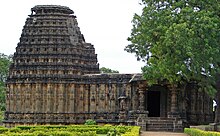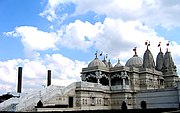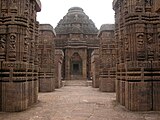Hindu temple architecture: Difference between revisions
→Temple Architecture Gallery: why is this here? More cleanup to come |
→Temple Architecture Gallery: tag originally placed last month |
||
| (One intermediate revision by the same user not shown) | |||
| Line 67: | Line 67: | ||
==Temple Architecture Gallery == |
==Temple Architecture Gallery == |
||
<!--Khatu Shyam ji Temple Gallery--> |
<!--Khatu Shyam ji Temple Gallery--> |
||
{{Too many photos|date=May 2011}} |
|||
<!-- Effort should be made to provide context-giving captions and links to these pics below --> |
<!-- Effort should be made to provide context-giving captions and links to these pics below --> |
||
<gallery caption="Hindu Temple Architechture Gallery" widths="180px" heights="120px" perrow="3"> |
<gallery caption="Hindu Temple Architechture Gallery" widths="180px" heights="120px" perrow="3"> |
||
Revision as of 21:37, 2 June 2011



| Part of a series on |
| Hinduism |
|---|
 |
India's temple architecture is developed from the sthapathis' and shilpis' creativity. In general these are from the Vishwakarma (caste). A small Hindu temple consists of an inner sanctum, the garbha griha or womb-chamber, in which the image is housed, often circumambulation, a congregation hall, and possibly an antechamber and porch. The sanctum is crowned by a tower-like shikara. At the turn of the first millennium CE two major types of temples existed, the northern or Nagara style and the southern or Dravida type of temple. They are distinguishable by the shape and decoration of their shikharas (Dehejia 1997).
- Nagara style: The tower is beehive shaped.
- Dravida: The tower consists of progressively smaller storeys of pavilions.
The earliest Nagar temples are in Karnataka (e.g. Galaganath at Pattadakal) and some very early Dravida-style temples (e.g. Teli-ka-Mandir at Gwalior) are actually in North India. A complex style termed Vesara was once common in Karnataka which combined the two styles.
This may be seen in the classic Hindu temples of India and Southeast Asia, such as Angkor Wat, Brihadisvara Temple, Khajuraho, Mukteshvara, and Prambanan.
Design and history

The temple is a representation of the macrocosm (the universe) as well as the microcosm (the inner space).
The Magadha empire rose with the Shishunaga dynasty in around 650 BC. The Ashtadhyayi of Panini, the great grammarian of the 5th century BC speaks of images that were used in Hindu temple worship. The ordinary images were called pratikriti and the images for worship were called archa (see As. 5.3.96–100). Patanjali, the 2nd century BC author of the Mahabhashya commentary on the Ashtadhyayi, tells us more about the images. Deity images for sale were called Shivaka etc., but an archa of Shiva was just called Shiva. Patanjali mentions Shiva and Skanda deities. There is also mention of the worship of Vasudeva (Krishna). We are also told that some images could be moved and some were immoveable. Panini also says that an archa was not to be sold and that there were people (priests) who obtained their livelihood by taking care of it.
Panini and Patanjali mention temples which were called prasadas. The earlier Shatapatha Brahmana of the period of the Vedas, informs us of an image in the shape of Purusha which was placed within the altar.
The Vedic books describe the plan of the temple to be square. This plan is divided into 64 or 81 smaller square, where each of these represent a specific divinity.
Amongst the foremost interpreters of Indian art and architecture are Dr. V. Ganapati Sthapati, Stella Kramrisch, Vidya Dehija, M.A. Dhaky, Lokesh Chandra, Kapila Vatsyayan, and Dr. Jessie J. Mercay . The greatest living traditional temple architect is Dr. V. Ganapati Sthapati (Chennai) the only living Shilpi Guru. He is followed by his grand nephew Santhanam Krishna Sthapati of Chennai. Both are associated with The American University of Mayonic Science and Technology, which teaches Vaastu Shastras and building architecture of Sthaptya Veda. The BAPS Shri Swaminarayan Mandir & Complex in Lilburn, Georgia (USA) is a great example of how traditional Hindu architectural elements have been combined with modern building codes and construction techiques. Tony Patel, Partner with Alpharetta, Georgia (USA) based Newport Design Group Architects served as the projects Coordinating Architect for the project. The firm has been involved in several other significant Indian religious projects as well.
Badami Chalukya architecture

The Chalukya style originated during A.D. 450 in Aihole and perfected in Pattadakal and Badami.[1]
The period of Badami Chalukyas was a glorious era in the history of Indian architecture. The capital of the Chalukyas, Vatapi (Badami, in Bagalkot district, North Karnataka in Karnataka) is situated at the mouth of a ravine between two rocky hills. Between 500 and 757 AD, Badami Chalukyas established the foundations of cave temple architecture, on the banks of the Malaprabha River. Those styles mainly include Aihole, Pattadakal and Badami. The sites were built out of sandstone cut into enormous blocks from the outcrops in the chains of the Kaladgi hills.
At Badami, Chalukyas carved some of the finest cave temples. Mahakuta, the large trees under which the shrine nestles.
In Aihole, known as the "Cradle of Indian architecture," there are over 150 temples scattered around the village. The Ladkhan temple is the oldest. The Durga Temple is notable for its semi-circular apse, elevated plinth and the gallery that encircles the sanctum sanctorum. A sculpture of Vishnu sitting atop a large cobra is at Hutchimali Temple. The Ravalphadi cave temple celebrates the many forms of Shiva. Other temples include the Konthi temple complex and the Meguti Jain temple.
Pattadakal is a (World Heritage Site), where one finds the Virupaksha temple; it is the biggest temple, having carved scenes from the Ramayana and the Mahabharata. Other temples at Pattadakal are Mallikarjuna, Kashivishwanatha, Galaganatha and Papanath.
Gadag Architecture style

The Gadag style of architecture is also called Western Chalukya architecture.[2] The style flourished for 150 years (1050 to 1200 CE); in this period, about 50 temples were built. Some examples are the Saraswati temple in the Trikuteshwara temple complex at Gadag, the Doddabasappa Temple at Dambal, the Kasivisvesvara Temple at Lakkundi, and the Amriteshwara temple at Annigeri. which is marked by ornate pillars with intricate sculpture.[3] This style originated during the period of the Kalyani Chalukyas (also known as Western Chalukya) Someswara I.
Kalinga Architecture style
The design which flourished in eastern Indian state of Orissa and Northern Andhra Pradesh are called Kalinga style of architecture.The style consists of three distinct type of temples namely Rekha Deula,Pidha Deula and Khakhara Deula.The former two are associated with Vishnu, Surya and Shiva temple while the third is mainly with Chamunda and Durga temples.The Rekha deula and Khakhara deula houses the sanctum sanctorum while the Pidha Deula constitutes outer dancing and offering halls.The example of Rekha deula are Lingaraj Temple, Jagannath Temple, Puri.The example of Khakhara deula are Vaital Deula.The Konark Sun Temple is an living example of Pidha deula.
Māru-Gurjara Temple Architecture
Māru-Gurjara Temple Architecture originated somewhere in sixth century in and around areas of Rajasthan. Māru-Gurjara Architecture show the deep understanding of structures and refined skills of Rajasthani craftmen of bygone era. Māru-Gurjara Architecture has two prominent styles Maha-Maru and Maru-Gurjara. According to M. A. Dhaky, Maha-Maru style developed primarily in Marudesa, Sapadalaksa, Surasena and parts of Uparamala whereas Maru-Gurjara originated in Medapata, Gurjaradesa-Arbuda, Gurjaradesa-Anarta and some areas of Gujarat.[4] Scholars such as George Michell, M.A. Dhaky, Michael W. Meister and U.S. Moorti believe that Māru-Gurjara Temple Architecture is entirely Western Indian architecture and is quite different from the North Indian Temple architecture.[5] This further shows the cultural and ethnic separation of Rajasthanis from North Indian culture. There is a connecting link between Māru-Gurjara Architecture and Hoysala Temple Architecture. In both of these styles architecture is treated sculpturally.[6]
Temple Architecture Gallery
This article contains too many pictures for its overall length. (May 2011) |
- Hindu Temple Architechture Gallery
-
Vitthala temple with musical pillars, Hoysala style multigonal base Hampi
-
Somanath Temple, Junagadh, India
-
Dakshineshwar Kali Temple, built on a raised platform, in kolkata
-
Mahadeva Temple at Itagi (or Ittagi), 1112 CE, an example of dravida articulation with a nagara superstructure
See also
- Vastu Shastra
- Vedic altars
- Indian architecture
- Hoysala architecture
- Western Chalukya architecture / Gadag Style of architecture
- Chola art
- Indonesian architecture
- Rock-cut architecture
- Indian rock-cut architecture
- Architecture of Angkor
- Hemadpanthi architecture Style
References
This article includes a list of general references, but it lacks sufficient corresponding inline citations. (February 2008) |
- ^ "Echoes from Chalukya caves". Retrieved 2009-04-01.
- ^ "In search of Indian records of Supernovae1" (PDF). Hrishikesh Jogleka1, Aniket Sule, M N Vahia. Retrieved 2009-04-03.
- ^ "Kalyani Chalukyan temples, Temples of Karnataka". Retrieved 2009-04-03.
- ^ The sculpture of early medieval Rajasthan By Cynthia Packert Atherton
- ^ Beginnings of Medieval Idiom c. A.D. 900–1000 by George Michell
- ^ The legacy of G.S. Ghurye: a centennial festschrift By Govind Sadashiv Ghurye, A. R. Momin,p-205
- Dehejia, V. (1997). Indian Art. Phaidon: London. ISBN 0-7148-3496-3.
- Mitchell, George (1988). The Hindu Temple, University of Chicago Press: Chicago, IL. ISBN 0-226-53230-5
- Rajan, K.V. Soundara (1998). Rock-Cut Temple Styles. Somaiya Publications: Mumbai. ISBN 81-7039-218-7
External links
This article's use of external links may not follow Wikipedia's policies or guidelines. (August 2010) |
khatu shyam ji as Lord Krishna
- Tamil genius engineering
- Indian Temples
- Brihadishvara Temple from Indira Kalakendra
- Mukteshvara Temple from Indira Kalakendra
- Dravidian Temple Architecture
- Space and Cosmology in the Hindu Temple
- Hindu-Buddhist Southeast Asian Temples
- Hindu Javanese Temples
- Temples of India – A cultural synthesis
- Vijayanagara architecture
- Sthapatyaveda (Temple Architecture) on Hindupedia, the Hindu Encyclopedia




























